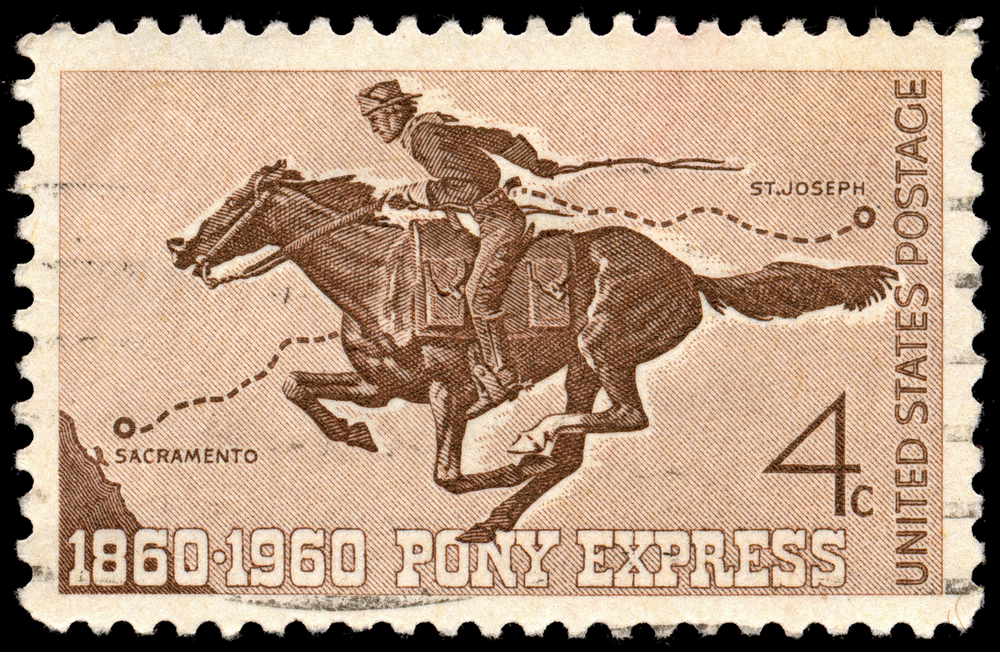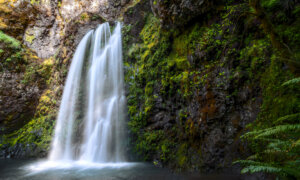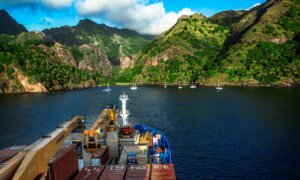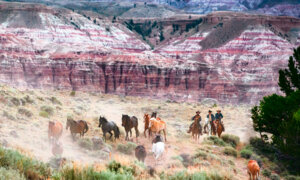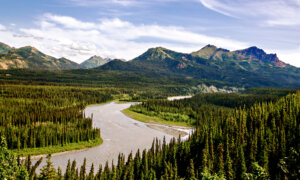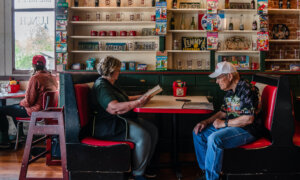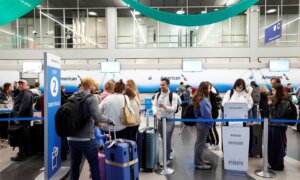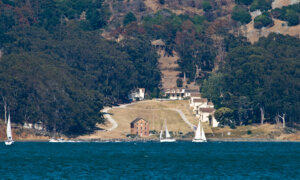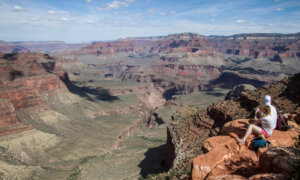Born and raised within a strong stone’s throw of Old Sacramento on the sycamore-shaded banks of the Sacramento River, I grew to know every nook and cranny of the charming corridor. Smiles and laughter and small faces smudged with ice cream give more the impression of a theme park than an authentic restoration with businesses ranging from art galleries to tattoo parlors.
Sacramento was the epicenter of the California Gold Rush of 1849, and the Western terminus of the Pony Express and the first transcontinental railroad in the 1860s. With the largest concentration of Gold Rush period buildings in the nation, Old Sacramento is a 28-acre national landmark and state historic park in the shadow of the city’s bustling downtown. Gleaming glass skyscrapers reflect stunning sunsets that glitter like gold on the regnant river running by rustic storefronts.
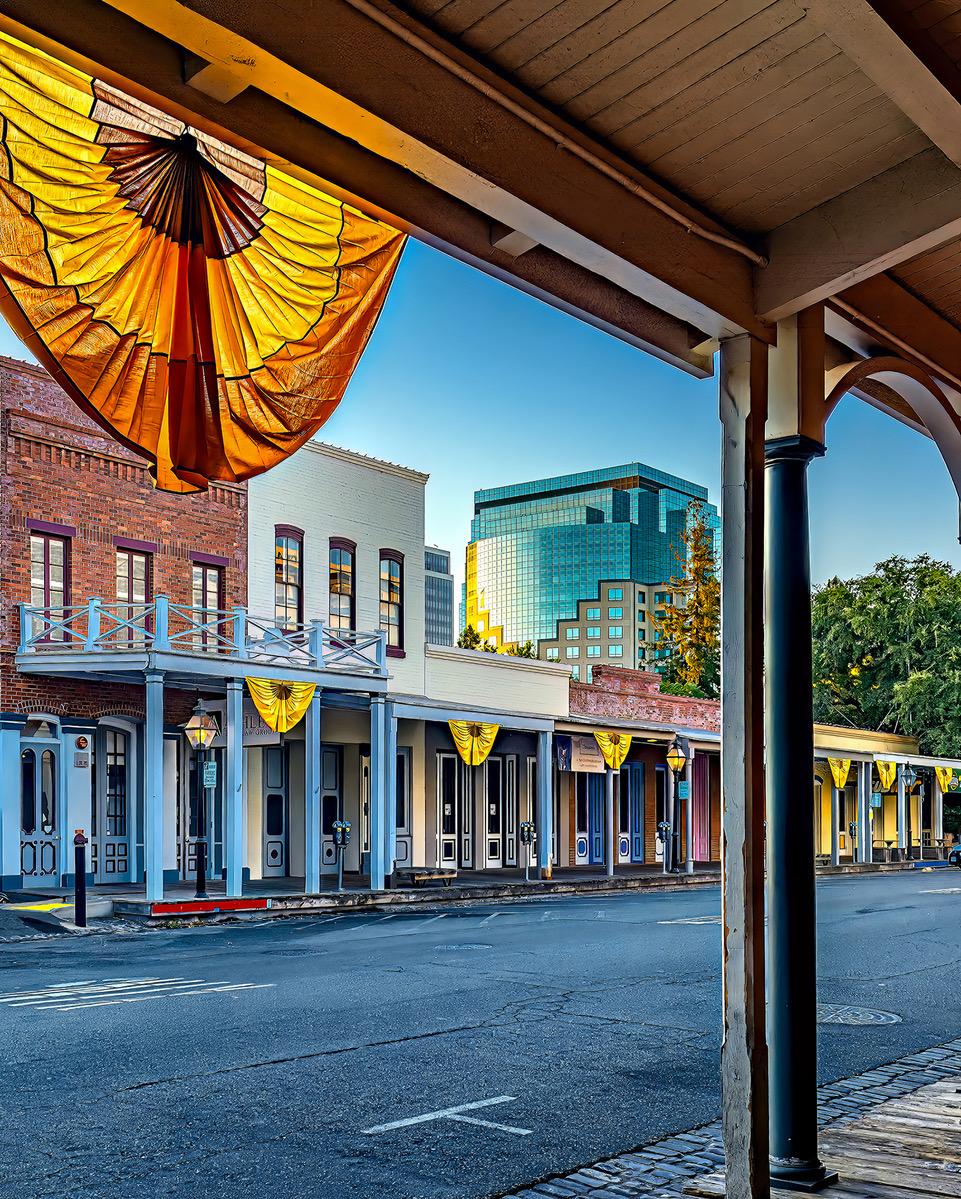
Old Sacramento is cradled between shining skyscrapers and the Sacramento River. (Maria Coulson)
The setting was not always inviting and picturesque. When renovation began in the mid-1960s, the waterfront was the most derelict area of the city. Unsavory characters frightened shoppers away from long established stores such as Breuners Furniture, which crafted walnut desks for the state senate in 1869, and Flagg Brothers Shoes, which carried the day’s fashion-craze Beatle boots. I was not in step with the footwear, but lived in a Depression-era house with Breuners furnishings.
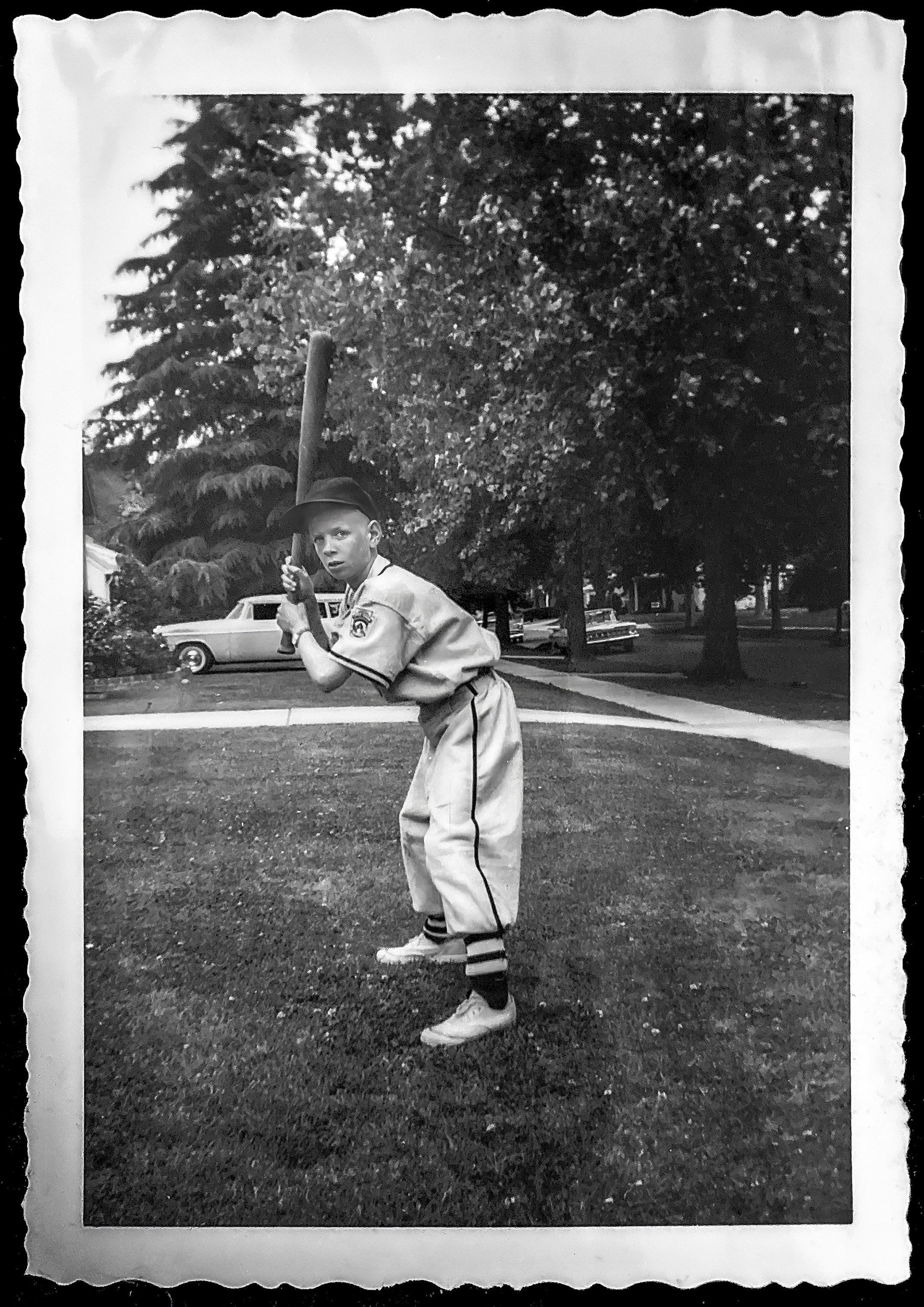
The writer several years younger than when he and his baseball buddies bicycled to the wretched waterfront. (Maria Coulson)
Skeletal Remains
Ignoring our parents’ admonitions and abandoning an afternoon baseball game, junior high schoolers astride sleek Schwinn 10-speeds pedaled hellbent for skid row. We rode through blocks of skeletons of once-imposing commercial buildings, and prowled through hulks of once-majestic paddlewheel steamboats. From the remnants, we tried to reconstruct the time and the town in our young minds.
An accomplice and I led the break from the ball field. In 1960, his father had opened the first renovated building: a 1853 firehouse in what would become Old Sacramento. One sweltering summer afternoon when we swung by the now acclaimed Firehouse Restaurant on our bicycles, I imagined sitting up at the mahogany bar with a frosty root beer, sizzling rib eye, and chilled chocolate mousse. My wife, Maria, and I fulfilled my boyhood fantasy while doing this story six decades later.
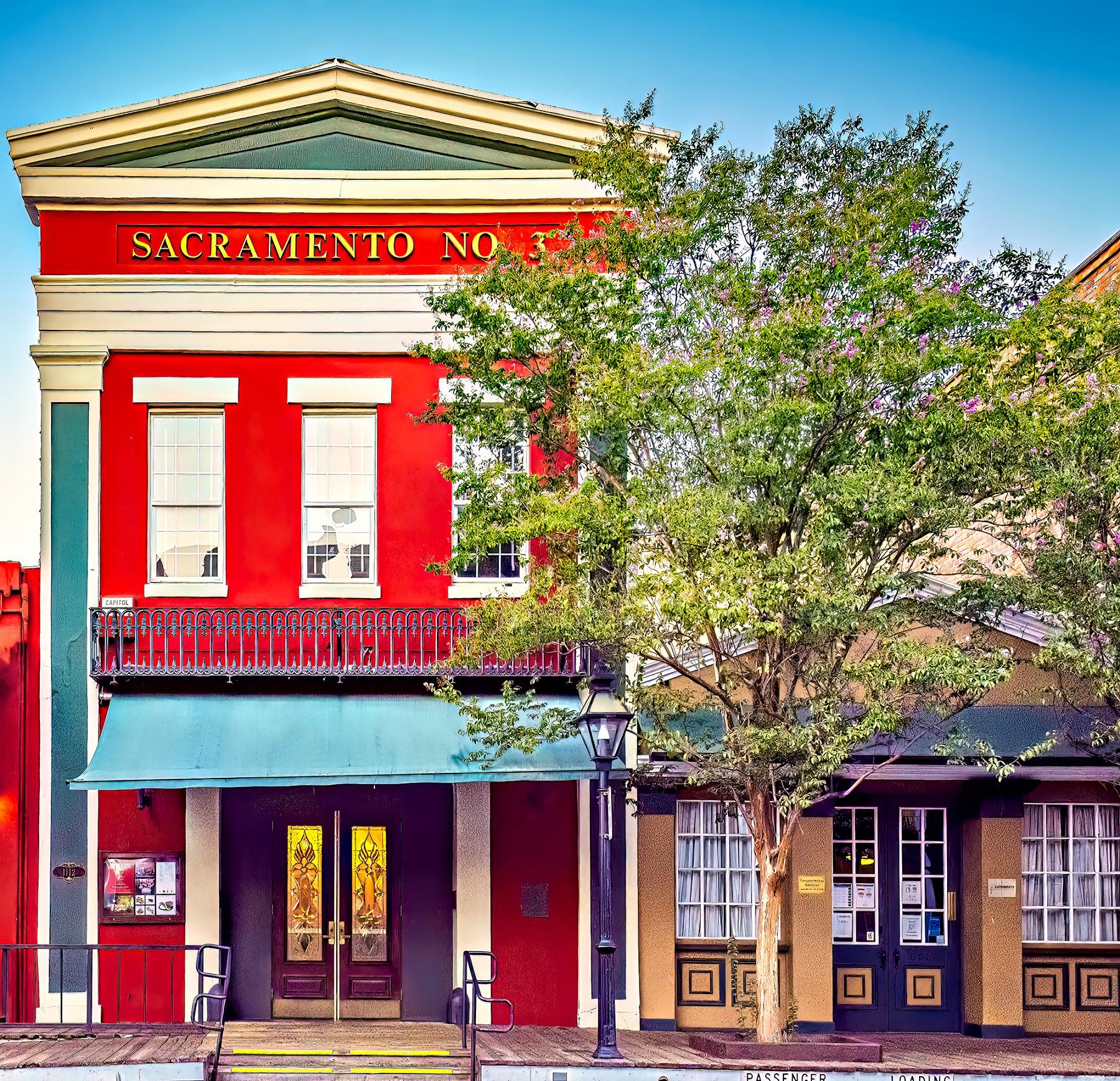
The historic district’s first renovated building was an 1853 firehouse converted into a restaurant in 1960. (Maria Coulson)
Worse for Wear Prospectors
Wondering what it would have been like to ride into Sacramento City on horseback or by stagecoach, we took a carriage ride. The cobblestone streets, broad boardwalks, and brick and wood buildings look much as they did nearly 175 years ago.
Strolling by souvenir and curiosity shops, we envisioned bushy-bearded prospectors in scruffy slouch hats, battered black sack jackets over faded red flannel shirts, threadbare trousers with mended suspenders, and broken-down boots elbowing their way through frenzied throngs into busting-at-the-seams chophouses and saloons, haberdasheries, and hotels. There, they grabbed some grub and guzzled down suds, bought new duds, and soaked in a tub. Next day, leaving the gas lights and the ladies of the night behind, the argonauts trudged back up into the Sierra foothills with newly shod pack mules stacked high with provisions to the rip-roaring mining camps that inspired adventure tales by Bret Harte and Mark Twain.

Statue of Pony Express rider galloping toward Western terminus in Sacramento. (Maria Coulson)
Pony Express Rider
The two-story brick B.F. Hastings Building is nearly the last standing structure in the country that had a Pony Express station. The service operated for 18 months during 1860 and 1861, between St. Joseph, Missouri, and the California capital. Riders carried mochilas of mail on horseback across often desolate and hostile territory in the astonishing time of 10 days. A 15-foot-high bronze statue projects the image that is synonymous with the Old West: the wiry Pony Express rider hunched forward in the saddle on his mustang, at breakneck gallop.
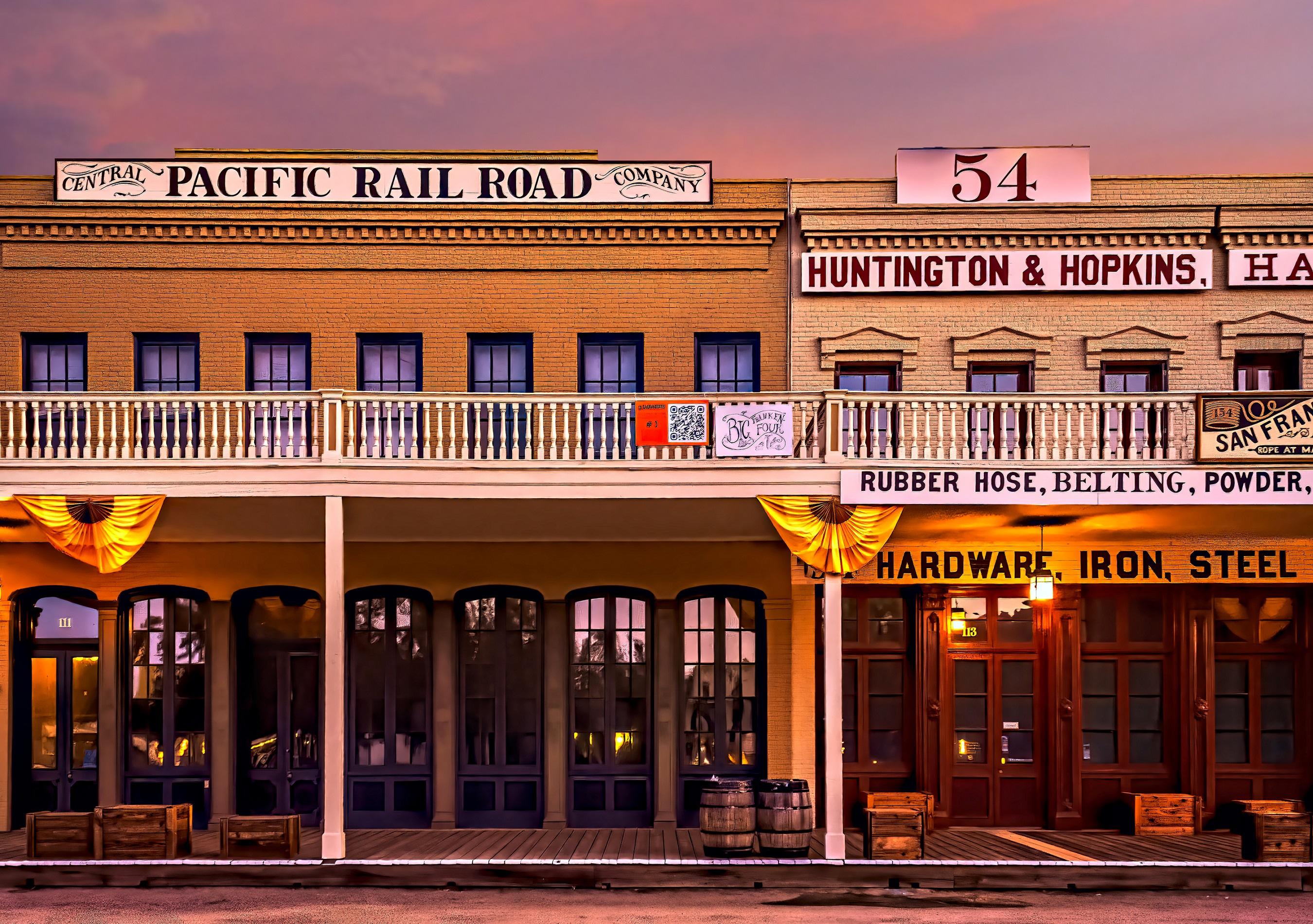
The Big Four Building was at the heart of business for the founders of the Central Pacific Railroad. (Maria Coulson)
Railroad Quartet
Constructed in the early 1850s, what became known as the Big Four Building housed Leland Stanford’s warehouse and Collis Huntington and Mark Hopkins Jr.’s hardware store, and was the headquarters of the Central Pacific Railroad. The three merchants, joined by dry goods proprietor Charles Crocker—for whom my elementary school was named—formed the Central Pacific quartet that conducted construction of the Western portion of the first transcontinental railroad, which was begun in 1863. Crossing the formidable Sierra Nevada required tunneling through thick granite and spanning vast ravines in deep snow and under blistering sun. Progress was often measured in inches or feet rather than miles, but proved an engineering triumph marveled at even today.
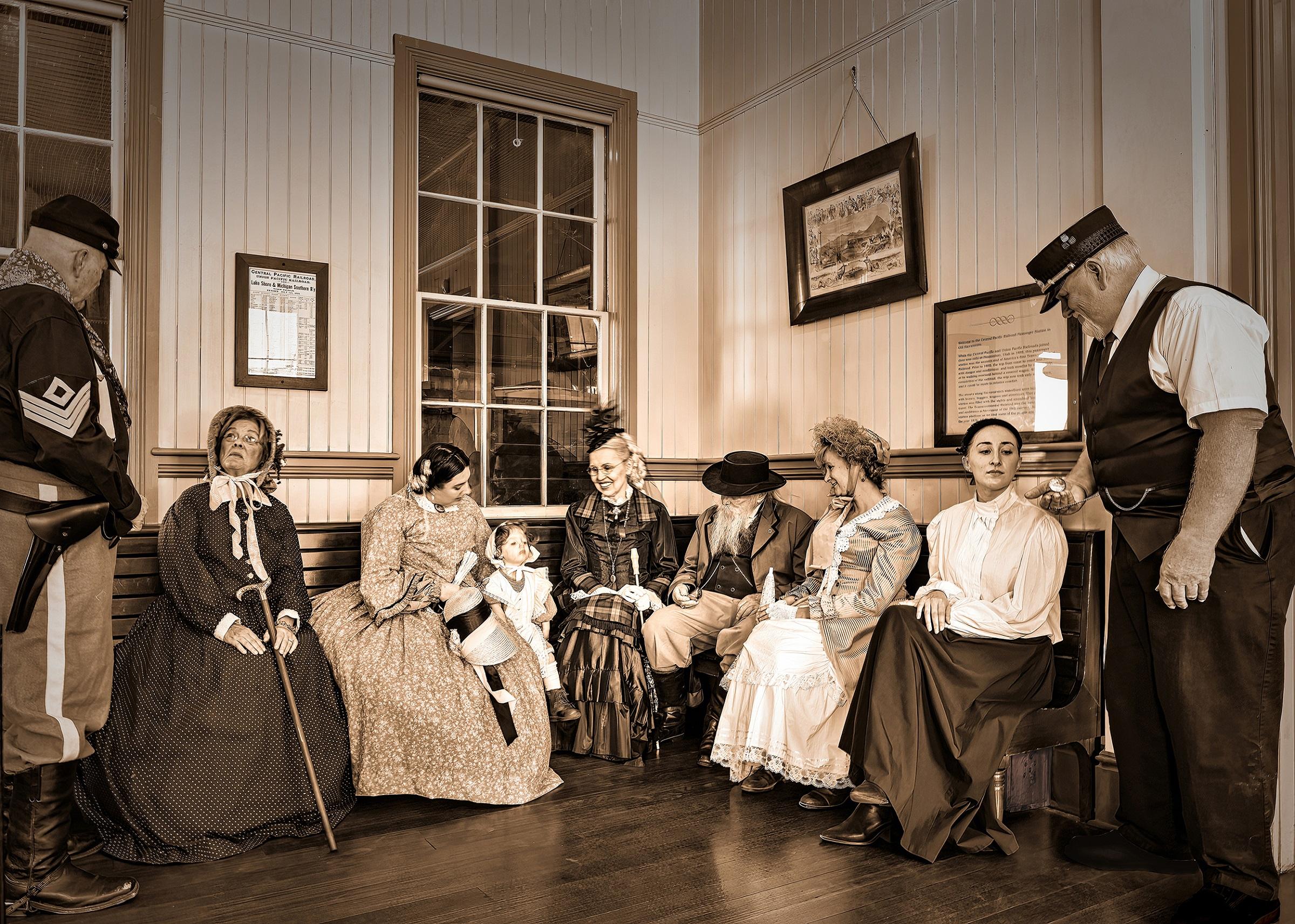
Old West Legends reenactors at railroad station waiting to go aboard Sacramento Southern excursion train. (Maria Coulson)
Iron Horse Heritage
The Central Pacific Railroad passenger station is a reconstruction of the Western terminus circa 1876. Steam or diesel-powered Sacramento Southern excursion trains run from the adjacent railroad freight station for a 50-minute round trip through old town and along the big river. We rode in a vintage railway car with a gregarious conductor who punched our tickets and handed out candy to the kids. Passengers may also choose open-air gondolas with bench seating or first class air-conditioned parlor cars with beverage service. The railroad museum foundation’s Kevin Hecteman in his book “Sacramento Southern Railroad” uses archival images and his encyclopedic knowledge to tell the story of the short line that commemorates its 120th anniversary this year.
The cavernous California State Railroad Museum—venue of my 30th high school reunion—boasts 19 meticulously restored steam locomotives dating from 1862, and historic railway cars, some you can go aboard. The original china and silverware in a dining car, a Pullman rocking sleeping car that simulates a night journey, and a colorful wooden cupola caboose give a sense of what it was like to travel by rail before interstates. The top floor displays delightful toy trains, some which chug through miniature countrysides, towns, and tunnels.
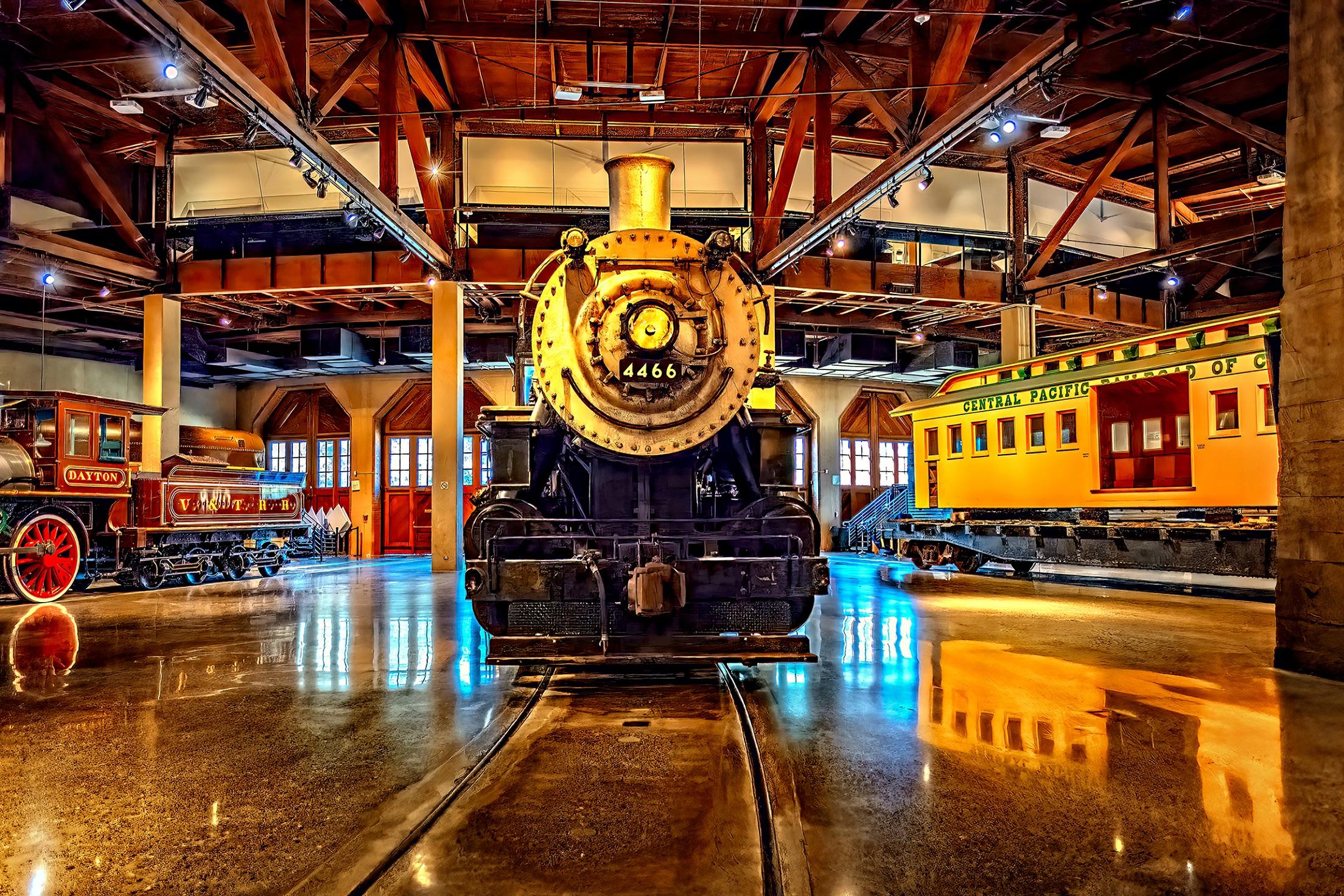
Union Pacific 4466 built in 1920 was the first steam locomotive used on Sacramento Southern excursions; the Virginia & Truckee line’s “Dayton” steam locomotive built in Sacramento in 1873 served Northern Nevada; the Central Pacific second-class railcar was also built in Sacramento in 1876. (Maria Coulson)
River Revenge
The winter of 1861 and 1862 was devastating for the community hastily built at the confluence of the Sacramento and American rivers. Heavy Sierra snowfall followed by a relentless deluge caused rapid runoff. The rivers broke through their levees and flooded the town; sweeping away railroads, demolishing buildings, and stranding survivors. “Sacramentans, huddled in trees, on high ground, on rooftops, looked upon a city that had been fantastically transformed into a sort of frontier Venice,” the Sacramento Bee wrote later. Gov. Leland Stanford reached his mansion by rowboat and climbed through a second story window.
In response to the Great Flood, about 1,000 buildings in the central business district were raised 10 feet over 13 years from 1864 to 1877. “The system of raising its buildings has its advantages,” Mark Twain quipped in 1869. “It makes the floor shady and this is something that is great in such a warm climate. It also enables the inquiring stranger to rest his elbows on the second-story windows and look in and criticize the bedroom arrangements of all the citizens.” How this remarkable engineering feat was achieved with jackscrews, manual crews, and work mules is explained during Sacramento History Museum underground tours. Guides in period costume that imaginatively portray actual early residents host them. A denizen duo escorted us.
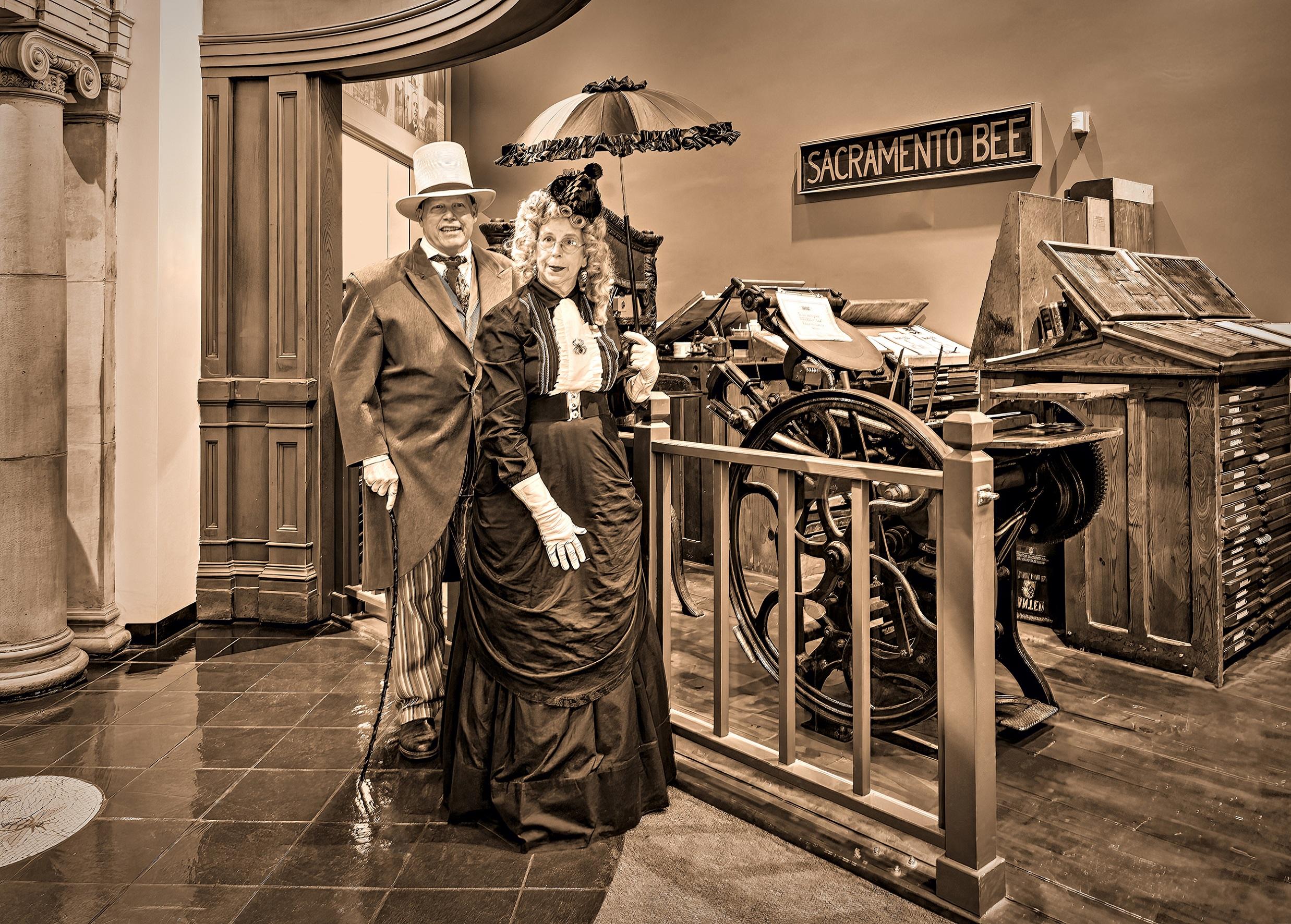
Tour guides Shawn Taylor and Jane Hastings in front of recreated 1850s to 1860s print shop exhibit in Sacramento History Museum. (Maria Coulson)
Gent and Belle’s Underground Tales
Debonair Robert Hamilton took out a monogramed handkerchief and wiped his brow on the warm, sunlit afternoon. Stuffing it back into his waistcoat pocket, he graciously invited us in a convincing Scottish brogue to accompany him. Dressed in long frock coat over his weskit, starched white shirt and silk tie, striped trousers, top hat, and holding a walking stick, tour manager Shawn Turner is Hamilton. With his set of keys, he unlocked doors that lead down to a series of narrow corridors and remote chambers that run under Old Sacramento.
As we made our way, Hamilton shared his story of sailing from Glasgow to the gold fields in late 1849. “Gold makes people crazy,” he said. “Who among us can keep our heads finding a great fortune? You come down to Sacramento City to celebrate and lose it all in the saloons and gambling halls.” Tiring of hard-luck prospecting, he stumbled onto success as a farm implements salesman. Hamilton said that the boomtown is in need of agricultural services, and that the merchants and the farmers will be the ones who ultimately prosper. “The reason it is called the Golden State is because of the wheat,” he said with a smile the size of the British Isle.
After greeting us in front of the museum’s 1852 printing press, Miss Odessa later joined our trio underground, sharing chatty confidences about the townsfolk in her fetching, feigned Southern accent. “If you don’t have the right purse,” she said brightly, “you can be thrown out of church; Methodist ladies are like that.” The mint julep belle is tour guide Jane Hastings attired in a 3/4-length-sleeve day dress. The bib is edged in frilly white lace, and the silk peau de soie shirt is festooned with a gracefully swagged apron. Her jauntily perched chapeau, collar, and belt are fashioned in velvet.
Born in Richmond, Virginia, on the Fourth of July, Miss Odessa came up river on the steamboat George Washington in summer 1849 at age 38, vowing never to marry again: “I married the first time with my heart, the second time with my spirit, and the third with my mind. If only God had seen it fit to put all of these traits into one mortal, my life’s journey would have been very different.” She was “enticed” to come to Sacramento City because of opportunities for “ladies like herself” not found on the East Coast. “I am the respected sole owner of a business, and didn’t have to get a husband in the bargain,” she said with a coquettish wink.
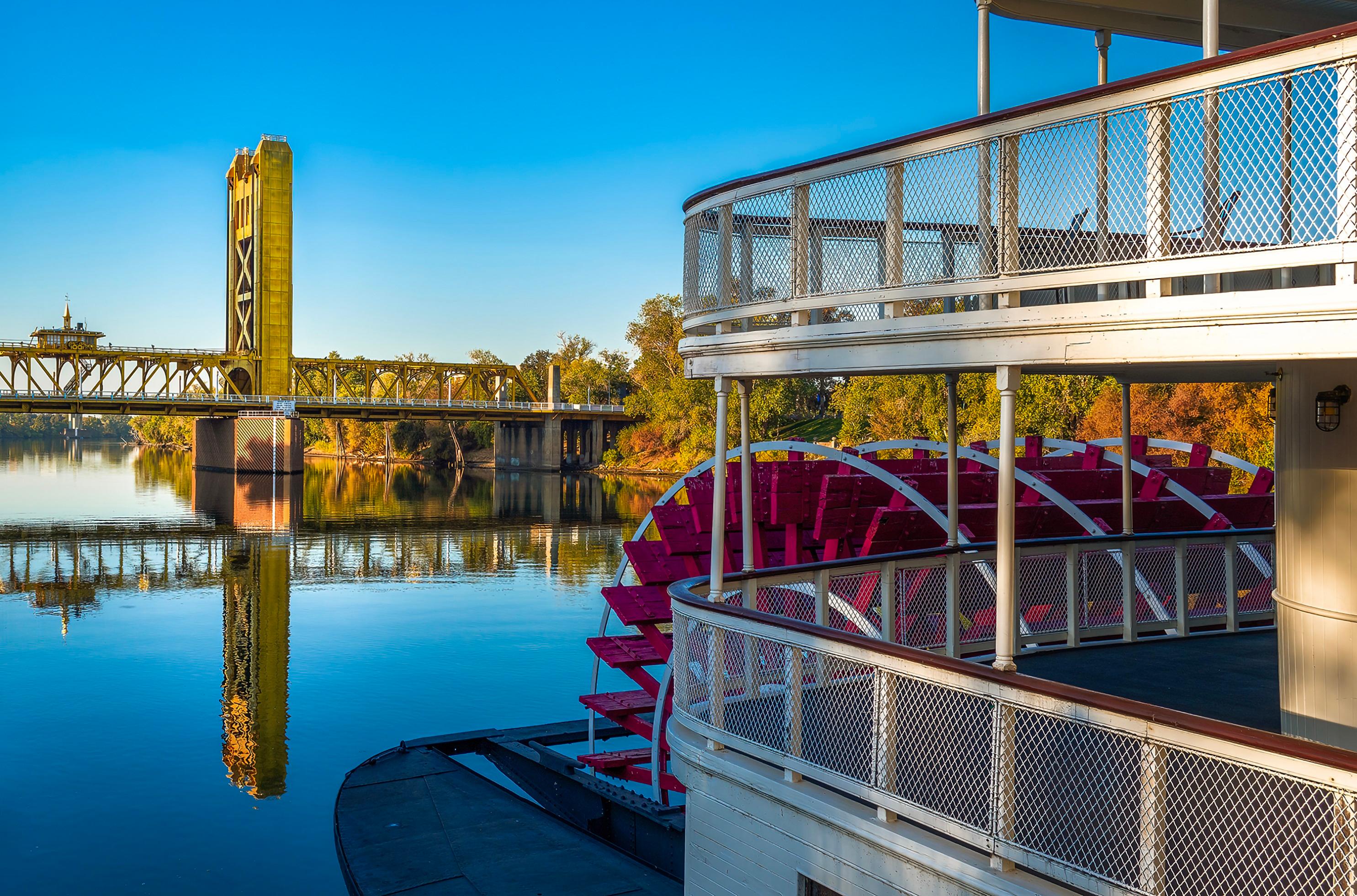
Delta King sternwheeler moored along the embarcadero and Art Deco style Tower Bridge. (Maria Coulson)
Jazz Age Riverboat
We boarded the 285-foot riverboat restored to its former glory and moored along the embarcadero. Built in 1927 and reminiscent of its mid-century predecessors, the Delta King has been converted into a Jazz Age, 44-room boutique hotel with richly wood-paneled grand dining room, where we were served local seasonal dishes. The Delta King and its twin, the Delta Queen, were the most lavishly appointed sternwheelers commissioned at the time. Until World War II, they plied the river between Sacramento and San Francisco on the 85-mile, nearly 11-hour overnight cruise that offered Prohibition drinking, dining and dancing, and gambling.
Yesteryear Today
Before the renovation of Old Sacramento, my school chums and I could only imagine what the Gold Rush-founded river town looked like from the skeletal remains shrouded in a silent, distant past. Today, you can saunter down the lively streets of humming businesses and get caught up in the infectious excitement. Beyond the bricks and mortar, the spirit of Old Sacramento recreates the energy and enthusiasm of the argonaut and iron horse age, and the atmosphere and adventure of the adolescent frontier town.









